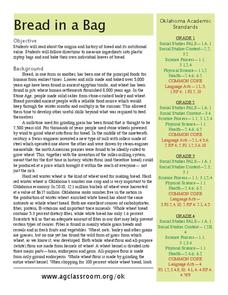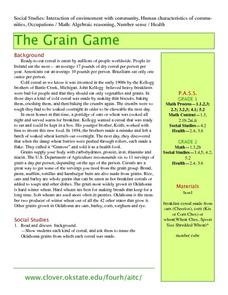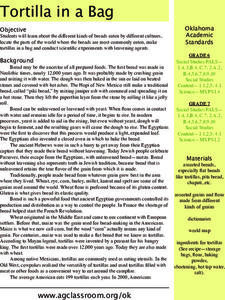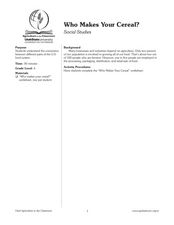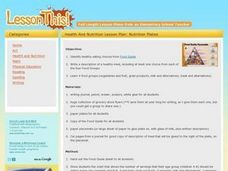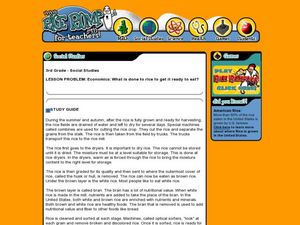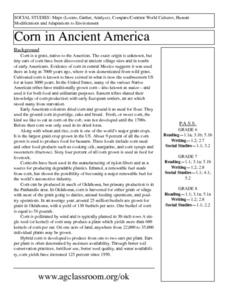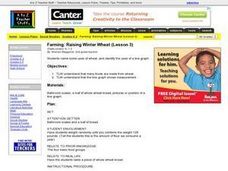Curated OER
Bread in a Bag
Learners explore wheat. In this bread making instructional activity, students make their own loaf of bread and discover the history behind wheat. They work in pairs to follow step-by-step instructions for making the bread. This...
Curated OER
The Grain Game
Students read and discuss origin of cereal, use pieces of cereal made from grains grown in Oklahoma to play counting game, name their favorite breakfast cereal, guess which grains are used to make their favorite cereals, and read...
Curated OER
Tortilla in a Bag
An engaging, and interesting lesson of types of bread found around the world awaits your charges. In it, learners compare and contrast manjy types of breads that come from cultures all over the globe. They utilize worksheets embedded in...
Curated OER
How Many Jobs In A Loaf Of Bread?
Students develop career awareness and skill building for job performance. After completing an inventory of interests and skills, students link their career choice to a the agricultural components contained in their choice. Thy determine...
Curated OER
Breads Around the World
Pupils read about bread. In this instructional activity studying bread, students read about the history of bread and it's significance around the world. Pupils identify the three main crops used to make bread and ten common types of...
Curated OER
Food Detectives
Students investigate the regions in which particular grains are grown. Using the packaging from a variety of foods, grains are identified and the general locations where they are grown are plotted on a map.
Curated OER
Who Makes Your Cereal?
Fourth graders investigate how cereal is produced. In this agricultural lesson, 4th graders discuss where ingredients in cereal come from. Students use picture cards to identify the steps in producing cereal.
Curated OER
Economics: What Are Some Other Uses for Rice?
Sixth graders investigate ways rice is sold by creating a chart of the different rice foods. In this economics lesson, 6th graders examine their local food store and list at least 10 rice by-products in a class chart. Students discover...
Curated OER
Oklahoma Wheat on the World Market
Sixth graders explore profit and loss in the wheat trading market. In this sixth grade mathematics lesson/social studies lesson, 6th graders play a “Wheat Market Trading Game” in order to investigate the concept of supply and...
Curated OER
Nutrition Plates
Students investigate healthy eating habits by studying the food pyramid. In this personal health lesson, students write a recipe for a healthy meal including one item from each section of the four food groups. Students...
Curated OER
Economics: What is done to rice to get it ready to eat?
Third graders create a map showing the journey of rice from the field to the grocery store. In this agriculture lesson, 3rd graders discover and map the process of harvesting and preparing rice to be packaged and shipped to sell to...
Curated OER
Corn in Ancient America
Students explore the importance of corn to the survival of early civilizations of the Americas. Through research and discussion activities, they read and describe how corn was used as food and currency in early civilizations. They...
Curated OER
Corn in Legend and Myth
Seventh graders compare myths and legends about corn and use creative abilities to act them out. In this corn legends lesson, 7th graders read background information about corn and its importance. Students work in groups to research...
Curated OER
Paleo-Indian Traditions
Seventh graders, in groups, name and describe the three traditions of the Paleo-Indian period.
Curated OER
Foul Food in the Middle Ages
In this Medieval Ages food worksheet, learners learn about the details behind the diets of both peasants and nobles during Medieval Times and fill out a chart based on their reading.
Curated OER
Where in the World is Utah Wheat?
Students examine the role of climate and landforms in the use of Utah's land. In this geography lesson, students analyze the relationship between geography and agriculture in the state as they examine data regarding wheat production in...
Curated OER
Farming: Raising Winter Wheat (Lesson 3)
Students identify foods that are made from wheat. They use a line graph to explain measurement. They identify foods from the food groups and explain how temperature, prefcipitation and natural resources affect the growth of wheat.
Curated OER
Wheat: Ancient and Ageless
Pupils label the parts of a wheat plant on a worksheet. In this Egyptian farming lesson, students thresh a wheat stem and estimate the amount harvested. Pupils research Ancient Egypt online.
Curated OER
Kansas vs the U.S.
Students demonstrate an understanding of the physical and political geography of Kansas. They view maps and films to gain knowledge of Kansas. They calculate the percentage Kansas harvests for each crop out of the national total.
Curated OER
How Far Did It Travel?
Sixth graders read and discuss background and vocabulary. They use the background to develop a flow chart showing the movement of food from farm to table and work independently or in groups to complete an activity. They then use Internet...
Andre Dollinger
Reshafim: Bread, the Staff of Life
A look at the preparation of flour and the baking of bread in ancient Egyptian kitchens. Bread, the staff of life, was vital to all classes of Egyptians.
